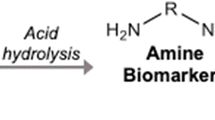Abstract
A 45-year-old mechanic employed in blowing hot air (350°–600°C) onto the surface of a polyurethane methylene diphenyl diisocyanate (MDI) conveyer belt developed dyspnoea, rhinoconjunctivitis and fever. The illness was suggestive of an MDI-associated illness, compatible with both immediate hypersensitivity and a complement-mediated immune-complex reaction. In his serum there were specific IgG and IgE antibodies against MDI and other isocyanates, and high values of circulating immune complexes. The patient's blood and urine samples were analysed for the presence of 4,4′-methylenedianiline (MDA) in hydrolysed urine and plasma. MDA was derivatized to amides using pentafluoropropionic acid anhydride (PFPA). Gas chromatography-mass spectrometry determinations were made monitoring the (M-20; M = molecular mass) fragments from the MDA-PFPA and the [2H2]MDA-PFPA derivative. The first urine sample was obtained 22 h and the last sample 114 h after start of exposure. The urine concentrations of MDA were corrected for creatinine. The half-time of MDA was 70–80 h. The first serum sample was obtained 19 h and the last sample 1967 days after the start of exposure. The half-time was 21 days, which suggests the presence of MDI/MDA plasma protein adducts in the exposed worker.
Similar content being viewed by others
References
Brorson T, Skarping G Sangö C (1991) Biological monitoring of isocyanates and related amines. IV. 2,4- and 2,6-toluenediamine in hydrolysed plasma and urine after test-chamber exposure of humans to 2,4- and 2,6-toluenediisocyanate. Int Arch Environ Health 63:253
Brunmark P, Persson P, Skarping G (1992) Determination of 4,4′-methylene-dianiline in hydrolysed human urine by micro liquid chromatography with ultraviolet detection. J Chromatogr 579:350–354
Brunmark P, Dalene M, Skarping G (1995) Biomonitoring of occupational exposure by determination of 4,4′-methylene dianiline in hydrolysed human urine and blood plasma using gas chromatography and negative ion chemical ionisation mass spectrometry. Analyst 120:41
Cocker J, Gristwood W, Wilson HK (1986) Assessment of occupational exposure to 4,4′-diaminodiphenylmethane (methylene dianiline) by gas chromatography-mass spectrometry analysis of urine. Br J Ind Med 43:620–625
Dalene M, Mathiasson L, Skarping G, Sangö C, Sandström JF (1988) Trace analysis of airborne aromatic isocyanates and related aminoisocyanates and diamines using high-performance liquid chromatography with ultraviolet and electrochemical detection. J Chromatogr 435:469–481
Dalene M, Skarping G, Brunmark P (1995) Assessment of occupational exposure to 4,4′-methylenedianiline by the analysis of urine and blood samples. Int Arch Occup Environ Health (in press)
Hagmar L, Nielsen J, Skerfving S (1987) Clinical features and epidemiology of occupational obstructive respiratory disease caused by small molecular weight organic chemicals. Monogr Allergy 21:42–58
Kennedy AL, Brown WE (1992) Isocyanates and lung disease: experimental approaches to molecular mechanisms. Occupational medicine: state of the art review, Hanley & Belfus, Philadelphia, 7:301
Lind P, Dalene M, Skarping G, Adamsson M, Hagmar L (1993) Determination of occupational exposure to toluenediisocyanate by biological monitoring in urine and plasma by gas chromatography-mass spectrometry. Br J Ind Med 50:1111–1118
Littorin M, Truedsson L, Welinder H, Skarping G, Mårtensson U, Sjöholm AG (1994) Acute respiratory disorder, rhinoconjunctivitis and fever associated with pyrolysis of polyurethane derived from diphenylmethane diisocyanate. Scand J Work Environ Health 20:216–222
Renman L, Sangö C, Skarping G (1986) Determination of isocyanate and aromatic amine emissions from thermally degraded polyurethanes in foundries. Am Ind Assoc J 47:621–628
Rosenberg C, Savolainen H (1986) Mass fragmentographic determination of urinary amine metabolites in rats exposed to degradation products from heated rigid polyurethan. J. Chromatogr 358:385–391
Skarping G, Renman L, Sangö C, Mathiasson L, Dalene M (1985) Capillary gas chromatographic method for the determination of complex mixture of isocyanates and amines. J Chromatogr 346:191–204
Skarping G, Brorson T, Sangö C (1991) Biological monitoring of isocyanates and related amines. III. Test chamber exposure of humans to toluene diisocyanate (TDI). Int Arch Occup Environ Health 63:83
Skarping G, Dalene M (1995) Determination of 4,4′-methylene diphenyldianiline (MDA) and identification of isomers in technical-grade MDA in hydrolysed plasma and urine from workers exposed to methylene diphenyldiisocyanate. J Chromatogr 663:209–216
Tiljander A, Skarping G, Dalene M (1989) Determination of 4,4′-methylenedianiline in hydrolysed human urine using derivatization and capillary gas chromatography with selected ion monitoring. J Chromatogr 479:145
Vandenplas O, Malo J-L, Saetta M, Mapp CE, Fabbri LM (1993) Occupational asthma and extrinsic alviolitis due to isocyanates: current status and perspectives. Br J Ind Med 50:213–228
Author information
Authors and Affiliations
Rights and permissions
About this article
Cite this article
Skarping, G., Dalene, M. & Littorin, M. 4,4′-Methylenedianiline in hydrolysed serum and urine from a worker exposed to thermal degradation products of methylene diphenyl diisocyanate elastomers. Int. Arch Occup Environ Heath 67, 73–77 (1995). https://doi.org/10.1007/BF00572229
Received:
Accepted:
Issue Date:
DOI: https://doi.org/10.1007/BF00572229




